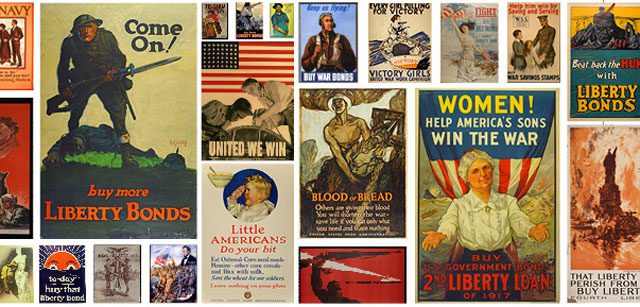
[dropcap]Gilcrease[/dropcap] Museum hosts two stimulating poster collections in April: Black Bodies in Propaganda: The Art of the War Poster and The Power of Posters: Mobilizing the Home Front to Win The Great War, both of which focus on the potent utilization of propaganda in times of global uprising.
“Black Bodies in Propaganda is based around posters that targeted African Americans and Africans to both support and enlist in wars waged by the United States and various European colonial powers,” says Mark Dolph, curator of the show. “These appeals for support were presented even as the very populations they were targeting faced oppression and injustice at home. Black Bodies in Propaganda helps guests gain an appreciation of how people of African ancestry have so often fought for the freedom of others when they themselves were treated as second-class citizens.”
The posters range in time from the U.S. Civil War to post-World War II – and as social awareness progressed over time, posters were created to shed light on the recurrent injustices faced by Africans and African-Americans.
“Following World War II, as Africans began to fight for their own independence from colonial rule, propaganda was used to build international support for their cause,” Dolph says. “The exhibition also includes highly stylized posters created in the Soviet Union and China expressing both support for oppressed blacks and condemnation of their capitalist oppressors.”
The adjoined show, The Power of Posters, focuses on President Woodrow Wilson’s efforts to mobilize the United States for entry into World War I. To reach this goal, Wilson began the Committee on Public Information just a week after announcing primary involvement in the war.
“The CPI’s most effective medium for the many messages their propaganda efforts conceived of were posters. Guests will see posters with highly illustrated graphics that encouraged enlistment in the military, food conservation and the purchase of Liberty Bonds,” Dolph says. “The intent of The Powers of Posters is to give museum guests an understanding of just what propaganda is – used both for good and not-so-good causes – and a sense of how the American government’s propaganda campaigns built support for the war on the homefront.”
Make no mistake; Gilcrease isn’t making a charged politic statement with these collections, but rather desires to elicit thoughtful dialogue between guests.
“I think most people view historical events through the lens of present events,” Dolph says. “I suspect that museum visitors will interpret both exhibitions based on their own experiences and political ideologies, both from the right and left sides of the political continuum. Neither exhibition was designed to ‘preach’ a particular point of view.”
Both shows open April 7 and run until July 9. Visit gilcrease.org for details.























